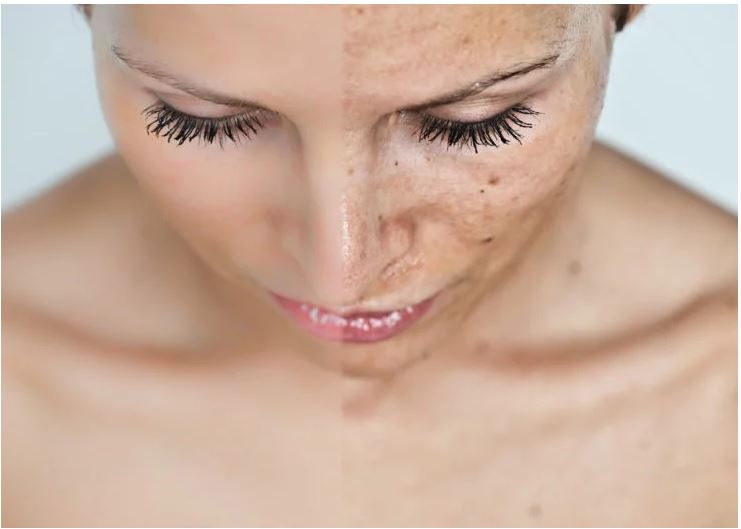There’s no question skin tone plays a tremendous role in the way your age, beauty, and health are perceived. But…did you know uneven skin tone can make others think you’re up to 20 years older—and less healthy—than you actually are? It doesn’t stop there, of course. Skin insecurities can make you feel self-conscious and deeply affect your quality of life—maybe even leading you to completely avoid certain places, events, or people altogether. Today, we’re going to help put you back in the driver’s seat of your skin health by talking about one of the most glaring signs of skin aging: Sunspots. Even better, we’re going to reveal exactly how to get rid of sunspots naturally.
What are Sunspots?
Sunspots, which are also called solar lentigines and lentigo senilis, are light-brown to black pigmented lesions of various sizes that typically develop in chronically sun-exposed skin. 1 Because of their color, sunspots are often called dark spots. And because they tend to develop over time and are so strongly related to how old you look, they are often called age spots. They are also sometimes called liver spots.
In simple terms, sunspots are the dark spots that give your skin a blotchy, uneven tone, often making you look much older than you really are.
Sunspots are associated with photodamage. That is basically science-speak for degenerative changes in the skin resulting from excessive exposure to UV radiation. One of the results of photodamage is photoaging. This more specifically refers to the appearance of premature skin aging caused by repeated exposure to UV radiation.
Practically speaking, there are many signs of photoaging. This can include deep wrinkles; rough, leathery skin; dry, lax skin; and perhaps most notably, loss of skin tone and mottled pigmentation (hypo- or hyperpigmentation). 2 We’re talking:
- Dull complexion
- Uneven skin tone
- Appearance of sunspots
Get this: In a study published in the journal Evolution and Human Behavior, a group of European researchers studying skin texture revealed the effects of skin color distribution can account for up to 20 years of perceived age. 3 In other words, uneven skin tone can make others think you’re up to 20 years older—and less healthy—than you actually are.
BREAKING: Doctors Can't Believe She Used This To Erase Her Wrinkles...
According to Dr. Bernhard Fink, study co-author and Senior Scientist in the Department for Sociology/Anthropology at the University of Goettingen, Germany, “Whether a woman is 17 or 70, the contrast of skin tone plays a significant role in the way her age, beauty, and health are perceived.”
Photoaging is not just about looking older (although that’s really important…after all, skin is the most visible indicator of aging). It’s also about being confident and comfortable in your own skin. It’s about feeling like you look normal, not like everyone is staring at you or feeling like you stick out like a sore thumb.
Quite simply, the association between youth and beauty is well accepted in modern-day society. Studies show people who have a more youthful appearance are consistently rated as more attractive than older-appearing folks. And vice versa, as people perceived as more attractive tend to be thought of as younger than their actual age. Not surprisingly, studies show we are drawn to people with younger-looking skin because we perceive it to be healthier and more attractive. 4
This same association between youth and beauty is also what fuels the cosmetic and surgical industries. And considering 80 – 90% of adults living in Europe and North America show detectable signs of photoaging, it’s no wonder so many people desperately want to know how to get rid of sunspots through safe, natural ways.
How Do Sunspots Appear?
If you want to know how to get rid of sunspots, you first need to know how they appear. Bear with me as this may get a little thick in the weeds. But don’t worry. We’ll tie everything up with a bow, and you’ll walk away knowing everything you need to.
The major determinant of the color in the skin is a compound called melanin. This compound is also produced by the body as a defense mechanism against UV radiation. And while healthy melanin production and processing is the secret behind a lovely suntan, the build-up of melanin is the major culprit behind sunspots.
In other words, like most things in the body, balance is important. Melanogenesis refers to the process of the body making melanin. It is a defense mechanism of the skin against UV irradiation. Melanin also acts as an antioxidant (removing reactive oxygen species), and it’s involved in the synthesis of vitamin D. 5
However, melanin overproduction and its accumulation in the skin is the driving force behind the appearance of sunspots. Along those lines, the key to revealing a more even skin tone—the solution to getting rid of sunspots—lies in healthy melanin metabolism.
The process involves multiple stages. While it’s quite complex, here’s an overview of what it entails… 5–7
- You expose your skin to UV radiation (i.e., sunlight), which triggers the process of melanogenesis via generation of free radical reactive oxygen species (ROS) and activation of melanin-stimulating hormone.
- Melanin production is initiated by a number of signaling systems and transcription factors (chemical messengers) including KIT, SCF, MITF, and MC1R. For example, MITF is considered a “master regulator” of melanin synthesis. You don’t need to remember the alphabet soup. Just keep in mind that there are chemical messengers on the “lookout” that set the cascade in motion.
- The body converts the amino acid L-tyrosine (the starting material for melanin production) to L-DOPA via the enzyme tyrosinase. This is the rate-limiting step in melanin production. And this occurs within the melanocytes (the cells that produce melanin). Basically, tyrosine is the “starter” compound that ultimately yields melanin. [Believe it or not, tyrosinase is the enzyme that is also responsible for the undesired browning reactions in damaged fruits during post-harvest handling and processing. 8]
- More specifically, this step occurs inside melanosomes, which are like little suitcases where melanin pigments are synthesized and stored.
- Melanin is transferred (via melanosomes) to keratinocytes (the cells located directly above the melanocytes in the skin). The number of melanosomes in keratinocytes is ultimately what contributes to what we see on the surface (i.e., pigmentation, skin tone, age spots, etc.)
You don’t need to memorize all this science-speak. But what you do need to appreciate is that melanogenesis is a complex, multi-stage process. Along those lines, a number of “steps” can be targeted, or “interrupted,” to help support healthy melanin metabolism—and ultimately help you if you want to know how to get rid of sunspots.
While sun damage is the most obvious and most talked about, there are many other factors that contribute to premature skin aging, including the appearance of sunspots: 4,9,10
- Poor diet (e.g., low antioxidant diet, nutrient deficiencies)
- Poor gut health
- Inadequate/poor sleep
- Stress
- Smoking
- Alcohol
- Environmental pollution
- Age-related hormone changes (e.g., menopause, andropause, somatopause)
- Poor glycemic control (i.e., blood sugar management)
- Certain medications
- And more
How to Get Rid of Sunspots
Step #1: Prevention
As you might have guessed, the first step to getting rid of sunspots is prevention. What that means is avoiding getting burned by the sun. Note that I did NOT say avoiding the sun or ruthlessly slathering on sunscreen. Those are unfortunately ignorant, albeit pervasive, recommendations that have contributed to an enormous host of UN-health consequences, including:
- Increased risk of all-cause mortality
- Certain types of cancer
- Hypertension
- Cardiovascular disease
- Type 2 diabetes
- Obesity
- Alzheimer’s disease
- Non-alcoholic fatty liver disease
- And more. 11
What I’m preaching here is non-burning sun exposure—not sun avoidance—which is actually protective against sunburn and promotes healthy melanin metabolism.
Step #2: Eat THIS – Nature’s Sunscreen
Peeling back the layers of how to get rid of sunspots, one of the most powerful natural ways to “disrupt” the melanin-production process is by consuming more antioxidants. These protect the skin from UV radiation and help inhibit melanogenesis. Remember, the generation of ROS triggers the UV-induced melanin-production process.
In particular, polyphenols seem to be especially potent when it comes to reducing the appearance of sunspots thanks to their powerful antioxidant properties that can help protect your skin against the environmental factors that age and discolor skin.
Polyphenols, which are plant-based chemicals that provide an array of health benefits, are naturally occurring phytochemicals that give plants their color and help protect them from the types of dangers plants encounter, including UV radiation.
That’s right, polyphenols are like “natural sunscreen” made by plants. And the cool thing is that once you consume the plants, their polyphenols may provide health benefits for you too—including helping you get rid of the appearance of sunspots.
Polyphenols can be found in a wide range of plants (yet another reason to eat your fruits and veggies). Here’s a list of some of the most well-known polyphenol-rich foods:
- Berries
- Cherries
- Plums
- Kiwi
- Grapes
- Tea
- Coffee
- Red wine
- Cocoa
- Apples
- Onions
- Kale
- Red cabbage
- Broccoli
- Carrots
- Radishes
- Beets
- Eggplant
- Spinach
- Oranges
- Grapefruit
- Lemons
- Legumes
- Peanuts
- Flaxseeds
- Sesame seeds
- Celery
- Hot peppers
- Parsley
- Thyme
- Cloves
- Peppermint
- Oregano
- Elderberry
Clearly, the take-home message is to eat more veggies and fruits and liberally season your foods with a variety of herbs and spices. Of course, that’s easier said than done. After all, only about 1 in 10 Americans meets the bare-bones minimum fruit and vegetable recommendations, let alone uses a range of ancient herbs and spices.
And while I highly encourage you to add more produce and plant-based foods and seasonings to your diet, the good news is there’s a simple, convenient, and powerfully effective way to add more polyphenols to your diet, a blend of more than 40 polyphenol-packed fruits, veggies, herbs, and spices (many we would probably never otherwise have access to).
Step #3: NOT That – Limit AGEs
Another mechanism that contributes to the appearance of sunspots is glycation. The most obvious example of glycation is something known as the Maillard reaction. This describes why food develops color (browning) and aromas when cooked.
Called exogenous glycation, it also occurs in the body, which is known as endogenous glycation. It happens when glucose (sugar) reacts with proteins. Because endogenous glycation is dependent on sugar in the diet, it’s no wonder a high-sugar diet that’s high in processed foods, poor glycemic control, and large swings in blood sugar accelerate glycation.
In the body, glycation leads to the production of advanced glycation end-products, or AGEs for short, which is quite an appropriate acronym considering it’s one of the fundamental mechanisms involved in aging. Indeed, glycation contributes to skin aging in a variety of ways. For example, AGEs accumulate in the skin where they damage collagen and stimulate melanogenesis—the very process behind the formation of sunspots. 12,13
In addition to eating a low-sugar diet composed primarily of nutritious, wholesome foods, you can also support healthy blood sugar metabolism and limit the production of AGEs by adding ingredients like berberine, cinnamon, quercetin, bitter melon, alpha-lipoic acid, and resveratrol to your regimen. No need to visit your local apothecary, though!
TRENDING: 1 Cup of This Melts Belly and Arm Fat (Take Before Bed)
Step #4: Naturally Tame Sunspots
While steps one through three will go a long way to helping you get rid of sunspots naturally, there’s an even more simple, effective solution. It was thoughtfully formulated with 7 powerful, naturally-derived trigger ingredients that can tame melanin to help reduce the appearance of sunspots and reveal brighter, younger, more even-looking skin.
Let’s take a look at the cutting-edge ingredients in this breakthrough skin-brightening serum and how they can help reduce the appearance of sunspots:
- Bellis perennis (Daisy) flower helps even skin tone and improve pigmentation by interfering with multiple pathways involved in the formation of melanin. Research has shown that application of Bellis extract results in significant improvements in skin brightness and reductions in the appearance of age spots on the skin in as little as four weeks.†
- DermalRx SRC is a natural exfoliating oligopeptide that helps gently loosen coarse, keratinized cells at the surface, stimulating skin renewal with younger cells. As a result, it actively refines and restores skin texture and tone, helping reveal younger, more radiant-looking skin and a refined skin appearance.†
- Niacinamide (vitamin B3) is a cornerstone in a skin-brightening serum, as it can help protect the skin from UV damage, reduce the appearance of lines and wrinkles, improve the elasticity of the skin, rebalance uneven skin tone, reduce discoloration, and support a refined skin appearance.†
- Brightenyl, also known as diglucosyl gallic acid (found in sumac trees), is a next-generation addition to this skin-brightening serum. It helps restore even skin tone by inhibiting the production of melanin, controlling the darkening of skin, reducing the appearance of dark spots on the face and skin, and restoring the skin’s natural tone.†
- B-White is a patented combination of naturally-derived ingredients, including a unique protein called oligopeptide-68, shown to reduce the appearance of age spots on the hands and neck after two weeks and reveal an overall brighter, more uniform complexion after four weeks.†
- SymWhite, also known as phenylethyl resorcinol (an antioxidant naturally found in pine bark), is a powerful player in this skin-brightening serum that has been shown to help support a brighter-looking complexion and more even skin tone in as little as 28 days.
- Gwennis is an extract of the algae Dictyopteris Polypodioides that helps support healthy melanin metabolism. Research has shown Gwennis significantly reduces skin pigmentation and reduces the appearance of age spots on the skin after three months of daily use.
Simply put, Ageless Bright was carefully formulated to provide key, naturally-derived, science-supported ingredients that have been shown to provide powerful, radiant support for healthier-looking skin, including helping you get rid of the appearance of sunspots.
How to Get Rid of Sunspots – A Recap
Research shows up to 90% of women and men today suffer from photoaging, the hallmark of which is sunspots—those dark, blotchy patches that make you look older than you actually are. In fact, sunspots lead to mottled pigmentation. And research shows that uneven skin tone can make others think you’re up to 20 years older, not to mention considerably less healthy.
Of course, our appearance is tied to more than just our perceived age. It’s also directly linked to our confidence levels, feelings of self-worth, and even our daily mood. After all, your skin (and how you look) is the billboard for your health and vitality that everyone sees.
Now that you know how to get rid of sunspots, the good news is you can make a fast and dramatic impact on all those old-looking skin contrasts by avoiding getting burned by the sun (but not avoiding the sun altogether), changing the way you eat (more powerful plants and less junk), and harnessing the power of key trigger ingredients that help stop the accumulation of melanin dead in its tracks.









